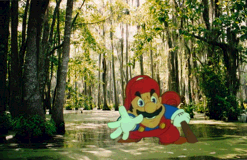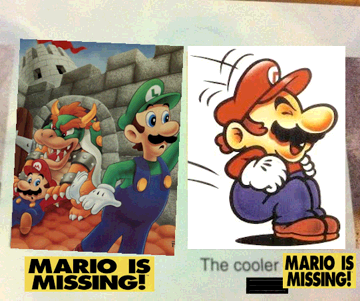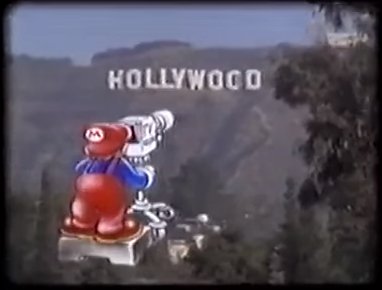Mario Takes America

(Don't mind me - I'm just a mockup using a development photo and a Super Show frame)
Welcome to the Mario Takes America micropage! This should be your one-stop shop for info relating to this lost Nintendo CD-i title!
Sections:
Info Table -- Development -- Gameplay and Plotline -- A Possible Screenshot??
Info Table
| Developer | Status | Available? | Genre(s) | Players |
|---|---|---|---|---|
| CIGAM | Unreleased Cancelled mid-production by Philips |
No - only behind-the-scenes screenshots |
Action FMV Edutainment |
1P |
Development
The information in this section (and the rest of the page) has been sourced from:
- Developer posts from the ASSEMbler Games forum
- The Unseen64 article (has bonus development screenshots)
- A 1993 issue of the British CD-i magazine
Mario Takes America was one of many projects kickstarted by the Philips and Nintendo collaboration, and was the first (and last) project created by Toronto-based game developer CIGAM. Development lasted from 1992 to 1994. In order to shoot the footage meant for their game, CIGAM shot a lot of on-location footage throughout America, often having to use helicopters to do so.
The first year of development was focused on obtaining this footage, and went over smoothly apart from the first programmer quitting within the first three weeks. In a sign of things to come, he looked over the CD-i's specs and decided to leave. Once the first year of development had passed, the CD-i's limitations started to falter Mario Takes America's progress. The background footage took up so much memory that there was little left for the game itself.
As a result of this, the art department of CIGAM had to chop out animation frames to save as much memory as possible. The end result was footage that was described by a crew member as "iffy - still better than anything else in 1992 but not what [he] had hoped for". Clips of Mario Takes America were shown at the New York CD-i 3 Conference in October 1993, as well as the 1994 Winter CES.
After two years of stagnated development - with only the game's first-person stages being coded and playable - Philips was unimpressed with Mario Takes America's progress and cut CIGAM's funding. In an attempt to save the project, the game's producer prepared a version of the game that replaced the Mario license and sprites with a generic rock & roll theme. This version of the game starred a rock & roll star named Metal (who looked like Dee Snider from Twisted Sister) and his large roadie assistant named Heavy.
In addition, a few of the sequences in Mario Takes America had variants where Sonic replaced Mario, in an attempt to get Sega's favor. However, they did not answer the producer's calls.
Eventually, CIGAM went bankrupt and its assets were reposessed by the CIBC - it's unknown (and doubtful) if they still have CIGAM's assets. Two VHS tapes of Mario Takes America-related footage exist, but both have never been posted publicly. The first is footage of the Metal & Heavy version of the game, and the second is a "making-of" video that contains location shooting and (basically) a promotion of the game's producer.
Gameplay and Plotline
Mario Takes America would've essentially been a action-adventure game that also served as an edutainment game about America's landmarks. In the game, Mario would travel across the United States of America in fifteen levels of fun - from arriving at New York City to ending up in Los Angeles - to attend the premiere of an "interactive film" about his exploits. He would've traveled in vehicles including motorcycles, a barrel, an old train, and even the Space Shuttle, and every enemy he would've fought had a different fighting style.
Mario Takes America would've required the CD-i's Digital Video Cartridge expansion. Its cutscenes depicted Mario as he appeared in the DiC Entertainment cartoons, in 2D animation that was shaded depending on light sources in the background footage. It would've been split across multiple gameplay types, including 2D platformers and first-person on-rails sequences. The 2D platformers had photographed backgrounds similar to Zelda's Adventure, while the first-person sequences had moving video backgrounds.
As mentioned, there are fifteen levels associated with Mario Takes America, and information on them is both scattered among multiple sources and conflicting at times. Using these sources (and a bit of location guessing), I've reconstructed a best-guess attempt at what Mario Takes America might've been. Read on, friend:
- New York City: The first level of the game, set in the city's skyline. It has two differing descriptions; one source claims that it was a 2D platformer shot from the left side of a helicopter, while the other states that it was a first-person level where Mario rode a helicopter. The song "New York, New York" would've played.
- Niagara Upper Rapids: A first-person level where Mario floated in a barrel down Niagara River, from its upper rapids to the famous Niagara Falls.
- Niagara Lower Rapids: A first-person level where Mario continued down Niagara River, going from Niagara Gorge to a whirlpool (Niagara Whirlpool?).
- Detroit: A level set in an automobile factory that was never completed. It's unknown what genre it would've been.
- Fort Knox: A 2D platformer stage set in the gold buillion reserve in northern Kentucky.
- Florida: A stage set on-board a Space Shuttle. Mario rides the shuttle and uses its Canadarm to both pull coins into the Shuttle Bay and punch enemies/asteroids for more coins.
- Louisiana: A first-person speedboat cruise around the alligator-filled bayou.
- Texas: A first-person stage set on top of a moving vintage train and its boxcars. Enemies such as Koopas would've climbed up the sides of the boxcars and fought Mario.
- Carlsbad Caverns: A 2D platformer stage set in the National Park in southeastern New Mexico.
- Badlands: A first-person motorcycle chase set in this region, apparently. My best guess is Badlands National Park in South Dakota, which is rather out of the way when compared to the other locations.
- Monument Valley: A motorcycle race level set on a highway at this Arizona National Park. CIGAM somehow got the rights for Steppenwolf's "Born To Be Wild" to play here. Likely a first-person stage.
- Las Vegas: A first-person stage that was never completed. It's unknown what it would've entailed - one source states it was a "neon race", while another states it was a fight with a boxer.
- Hollywood Sign: A 2D platformer stage where Mario chases "electrical charges" around the letters of this famous Hollywood landmark.
- Los Angeles: A first-person car race, set at night on a freeway. Might've taken place before the Hollywood Sign level.
- Graumann's Chinese Theater: The final stage of the game. It was a 2D platformer where Mario had to defeat all of the enemies he encountered during his adventures in the United States. It was never completed.
TL;DR? It's basically this:

A Possible Screenshot??

Okay, I was going to end this page after the level descriptions, but I found a strange screenshot while doing research for this segment. It's Mario at the Hollywood Sign, just like the level in the above list. This image was initially posted to Forest of Illusion's Twitter account in 2018, where they stated it was used in a 1993 VHS tape that informed people about upcoming games:

However, they did not specify the name of the VHS tape that the screenshot came from, and the original tweet was deleted when their Twitter account and site were deactivated. The only way we know about this link is that a couple of gaming news sites wrote articles about the discovery.
Given the year of the VHS tape, this picture could very well be a gameplay screenshot... or it could be a mockup of what CIGAM wanted the game to be like. It could also be promotional clipart for the 1993 Super Mario Bros. movie, though why it's in a tape about upcoming games is a bit odd. (And, depending on when the tape was made, they could have just used stills or footage from the film!)
Until we find that VHS tape, we can't say for certain.
So... if any of you know what 1993 gaming VHS this picture originated from, let me know!
(And thanks to Tumblr user "lorkhantheman" for providing information regarding its online origin!)
Return to top
Last updated: November 14th, 2025.